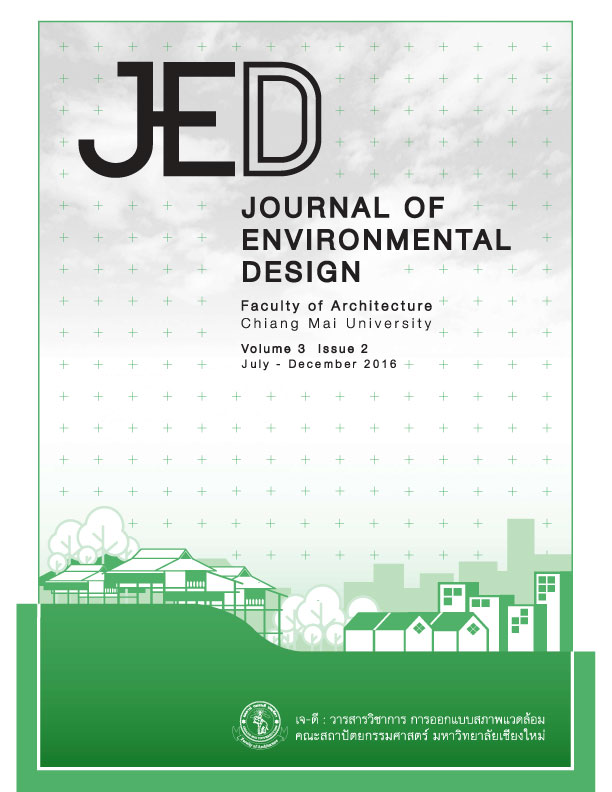การผสานองค์ความรู้ในการพัฒนาฌาปนสถานสู่การเป็นพื้นที่ชุมชน (Knowledge integration for cemetery and crematory development as a community space)
Main Article Content
บทคัดย่อ
การปรับปรุงสุสานให้กลายเป็นพื้นที่ชุมชนนั้นได้รับความนิยมมาอย่างยาวนานในต่างประเทศ ในปัจจุบันความพยายามที่จะพัฒนาฌาปนสถานให้กลายเป็นพื้นที่ชุมชนในประเทศไทยนั้นมีจำนวนมากขึ้นอย่างเห็นได้ชัดเนื่องจากการสนับสนุนของรัฐ กรณีศึกษาในประเทศไทยกรณีหนึ่งคือการปรับเปลี่ยนป่าช้าวัดดอนเป็นพื้นที่ชุมชนที่ประสบความสำเร็จในการทำพื้นที่ฌาปนสถานในเมืองให้กลายเป็นพื้นที่ชุมชน เชียงใหม่เป็นอีกเมืองหนึ่งที่เห็นได้อย่างชัดเจนถึงความพยายามพัฒนาฌาปนสถานหลายแห่งให้กลายเป็นพื้นที่ชุมชน ฌาปนสถานช่างเคี่ยนเป็นพื้นที่หนึ่งซึ่งได้รับการพัฒนาจนได้รับความนิยมในการเข้าไปใช้งานจากคนในชุมชน ในขณะที่หลายฌาปนสถานไม่ได้รับความนิยมมากนัก เช่น ฌาปนสถานหายยา ที่แทบไม่มีผู้คนเข้าไปใช้งาน ทั้งๆ ที่ตั้งอยู่ในชุมชนเมืองเช่นเดียวกัน นำมาซึ่งคำถามที่ว่าเหตุใดผู้คนจึงเข้าไปใช้ฌาปนสถานแห่งหนึ่งในการเป็นพื้นที่ชุมชนมากกว่าอีกแห่งหนึ่ง และทำให้เกิดสมมติฐานว่า สาเหตุหนึ่งของการที่ผู้คนไม่เข้าไปใช้งานในฌาปนสถานนั้น เนื่องมาจากฌาปนสถานที่ถูกพัฒนาให้กลายเป็นพื้นที่ชุมชนนั้นๆ ไม่มีลักษณะที่ส่งเสริมให้เกิดกิจกรรมเลือกที่จะทำและกิจกรรมทางสังคม ซึ่งลักษณะที่ไม่ส่งเสริมดังกล่าวเกิดขึ้นจากปัญหาการขาดองค์ความรู้ในการพัฒนาฌาปนสถานให้กลายเป็นพื้นชุมชนและขาดการทำเอกสารคู่มือแนวทางการพัฒนาฌาปนสถานที่ชัดเจนสำหรับผู้ที่เกี่ยวข้องในการพัฒนาปรับปรุงฌาปนสถานโดยในบทความนี้ผู้เขียนเสนอว่าองค์ความรู้ในการพัฒนาฌาปนสถานเพื่อเป็นพื้นที่ชุมชนนั้นควรประกอบขึ้นจากการผสานองค์ความรู้สามส่วนคือ 1) มาตรฐานฌาปนสถาน 2) ลักษณะของพื้นที่ชุมชนที่ส่งเสริมให้เกิดกิจกรรมทางสังคม และ 3) ลักษณะของชุมชน
In many countries, improvements toward cemeteries to become community spaces are very popular for more than over a hundred year. As well as in Thailand at the present, supported by government, there are increasingly efforts to develop cemeteries and crematories as community spaces. Wat Don Cemetery is one of a very successful case study that able to change a negative area in the city into the community space that people love to spend time to do their everyday life activities. Chiang Mai is also one of the city that cemetery and crematory developments can be seen. Chang Khian cemetery is one of a popular space that people who live in the community tend to spend their time there. Unlike Haiya crematory that lacks of activities especially physical activities sports around crematoriums area. This situation leads to the question: why people use particular cemetery as their community space than other cemetery? And also brings the hypothesis that one of the reason that people don’t use particular cemetery or crematory as their community space because it lacks of physical setting that promotes optional and social activities. And these negative characteristics caused by the lack of knowledges in crematory and cemetery development as a social space and also lack of specific documents and handbooks to be used as guidelines for the developers. In this article we suggest that the knowledge of crematory and cemetery improvements as social spaces should be consist of at least three parts which are the standard of crematory and cemetery, the characteristics of social space, and the characteristics of that particular community.


